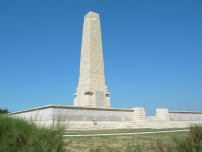| First Name: | William | Last Name: | BACON | |
|---|---|---|---|---|
| Date of Death: | 09/05/1915 | Lived/Born In: | Clapton | |
| Rank: | Private | Unit: | Essex1 | |
| Memorial Site: | Helles Memorial, Gallipoli | |||
Current Information:Born-Hackney
Gallipoli On 25 April, British, Australian and New Zealand forces landed on the Gallipoli peninsula. The plan was that these forces would soon defeat a demoralised Turkish army, knock Turkey out of the war, open up the Mediterranean to the Russian navy and threaten Austro-Hungary from the south. None of these things were achieved despite nine months of hard fighting in terrible conditions. The Turkish soldiers were much tougher fighters than had been given credit for and they were of course fighting an invasion of their homeland. The terrain, a series of steep rocky ridges and deep gullies made the fighting much more difficult and during the hot summer of 1915, the flies arrived in biblical proportions. Another seven British divisions were sent to Gallipoli during the summer but little or no progress was made. In the end, a new Commander was appointed and plans to evacuate the entire force were drawn up. By January 1916, all British, Australian and New Zealand forces had left Gallipoli, leaving behind only the dead, over 56,000 of them. The Second Battle of Krithia 6th-8th May, 1915 First World War generals and commanders did not emerge from the conflict with their reputations untarnished and although in many cases this was undeserved this was certainly not the case with Major General Hunter-Weston when he commanded the 29th Division in Gallipoli and this was no more evident than with his handling of the Second Battle of Krithia. His plan to attack and capture the village of Krithia and the commanding heights of Achi Baba beyond it were fatally flawed from the start. The plan was to advance along a line across the peninsular and that was about it. But the British had no idea where the Turks were, how strong their defences were and indeed how many of them were there. All they could do was blast away with the limited ammunition that the artillery had and hope that they hit some sort of target before sending in the infantry. The overall commander at Gallipoli, General Ian Hamilton, suggested that he attack in the early hours before sunrise when the Turks would not be able to see what was coming but Hunter-Weston was strictly a 9am-5pm sort of General, so the attack took place in broad daylight. British troops began the attack mid morning on 6th May moving forward along the spurs running down the peninsular but they never advanced more than 400 yards. Undeterred Hunter-Weston ordered the same tactic for the next day with the same results. On 8th May he ordered the two Australian and New Zealand brigades that had been brought round to Helles from Anzac Cove for the attack, into the action. They gained another 400 yards but a tremendous cost in casualties. Over the three days Allied casualties amounted to over 6000 and they came nowhere near to reaching their objectives. The 1st Essex battalion of 88 Brigade were engaged in this battle after which they were relieved from the front line and moved back to the beach area. On 9th May, 1915, William Bacon died from wounds received during Second Krithia. |
||||
| « Back to Search Results | ||||
| If you think any of the information shown here is incorrect, Click Here to submit your amends and comments | ||||




